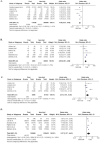Frailty Status as a Predictor of Outcomes in Emergency Surgeries for Older Adults: A Systematic Review and Meta-Analysis
- PMID: 40519493
- PMCID: PMC12166765
- DOI: 10.7759/cureus.84160
Frailty Status as a Predictor of Outcomes in Emergency Surgeries for Older Adults: A Systematic Review and Meta-Analysis
Abstract
The global aging population has brought increasing attention to frailty as a critical predictor of health outcomes. Defined by the British Geriatric Society as a state of diminished physiological reserve across multiple systems, frailty reflects a heightened vulnerability to adverse events. While the negative impact of frailty is well established in elective surgical settings, its influence on outcomes following emergency abdominal surgery remains less clear. This meta-analysis evaluates postoperative outcomes in frail versus non-frail elderly patients undergoing emergency abdominal surgery. A comprehensive search of eight electronic databases was conducted from inception to January 2024, with an additional search in June 2024. Eligible studies were selected based on predefined inclusion criteria. The primary outcome was postoperative mortality, with secondary outcomes, including complications, length of hospital stay, discharge destination, readmission, and reoperation rates. Data were synthesized using RevMan5 (Cochrane Collaboration, London, UK) and R (R Development Core Team, Vienna, Austria), applying both fixed and random-effects models. Risk of bias in individual studies was assessed using the Quality in Prognostic Studies (QUIPS) tool. Thirty-one studies involving 1,750,195 participants were included. Frail patients showed significantly increased 30-day (OR: 2.83, 95% CI: 2.45-3.27; p<0.00001) and 12-month (OR: 1.97, 95% CI: 1.32-2.93; p=0.0008) mortality. They also experienced higher overall morbidity, more severe complications (Clavien-Dindo ≥3: OR: 2.39, 95% CI: 1.82-3.13; p<0.00001), longer hospital stays (WMD: 3.74 days, 95% CI: 1.54-5.94; p=0.0008), and increased rates of readmission and reoperation (OR: 1.48, 95% CI: 1.25-1.75; p<0.00001). Discharge to rehabilitation or skilled nursing facilities was also more common among frail patients. These findings demonstrate that frailty significantly worsens postoperative outcomes in elderly patients undergoing emergency abdominal surgery. Further research is warranted to explore the integration of frailty assessment tools in emergency settings to support surgical decision-making for this vulnerable population.
Keywords: acute abdominal surgery; complications; elderly patients; emergency surgery; frailty; mortality.
Copyright © 2025, Brincat et al.
Conflict of interest statement
Conflicts of interest: In compliance with the ICMJE uniform disclosure form, all authors declare the following: Payment/services info: All authors have declared that no financial support was received from any organization for the submitted work. Financial relationships: All authors have declared that they have no financial relationships at present or within the previous three years with any organizations that might have an interest in the submitted work. Other relationships: All authors have declared that there are no other relationships or activities that could appear to have influenced the submitted work.
Figures

















Similar articles
-
Implementation of a preoperative frailty screening and optimization pathway for vascular surgery patients is associated with decreased 30-day readmission.J Vasc Surg. 2025 Apr;81(4):965-972.e2. doi: 10.1016/j.jvs.2024.11.018. Epub 2024 Nov 22. J Vasc Surg. 2025. PMID: 39581332
-
Folic acid supplementation and malaria susceptibility and severity among people taking antifolate antimalarial drugs in endemic areas.Cochrane Database Syst Rev. 2022 Feb 1;2(2022):CD014217. doi: 10.1002/14651858.CD014217. Cochrane Database Syst Rev. 2022. PMID: 36321557 Free PMC article.
-
The impact of frailty on posttraumatic outcomes in older trauma patients: A systematic review and meta-analysis.J Trauma Acute Care Surg. 2020 Apr;88(4):546-554. doi: 10.1097/TA.0000000000002583. J Trauma Acute Care Surg. 2020. PMID: 32205823
-
Impact of frailty on short-term postoperative outcomes in patients undergoing colorectal cancer surgery: A systematic review and meta-analysis.World J Gastrointest Surg. 2024 Mar 27;16(3):893-906. doi: 10.4240/wjgs.v16.i3.893. World J Gastrointest Surg. 2024. PMID: 38577090 Free PMC article.
-
Frailty as a predictor of mortality in the elderly emergency general surgery patient.Acta Chir Belg. 2017 Dec;117(6):370-375. doi: 10.1080/00015458.2017.1337339. Epub 2017 Jun 10. Acta Chir Belg. 2017. PMID: 28602153
References
-
- Fit for frailty - consensus best practice guidance for the care of older people living in community and outpatient settings. [ May; 2025 ]. 2017. https://www.bgs.org.uk/sites/default/files/content/resources/files/2018-... https://www.bgs.org.uk/sites/default/files/content/resources/files/2018-...
-
- Frailty: diagnosis and management. Morley JE. J Nutr Health Aging. 2011;15:667–670. - PubMed
-
- Veronese N. Cham, Switzerland: Springer; 2020. Frailty and Cardiovascular Diseases: Research into an Elderly Population, 1st Edition.
-
- The world’s aging population. [ May; 2025 ];Alvarez P. (2023. https://frankdiana.net/2023/05/31/the-worlds-aging-population/ 2023 1950:20.
Publication types
LinkOut - more resources
Full Text Sources
